-
CENTRES
Progammes & Centres
Location
Data-driven, context-specific, integrated, and holistic policy interventions at the state level are needed to address acute and chronic malnutrition in India

Most regions worldwide are living through a global nutrition crisis. The nutrition crisis is one of the critical societal challenges in the 21st century. Poor nutrition is impacting health, socio-economic indicators, and the environment. “The world is moving backwards in its efforts to end hunger, food insecurity, and malnutrition in all its forms”, stated the authors of 2022 the report on “Food Security and Nutrition in the World”. The ongoing war in Eastern Europe and the COVID-19 pandemic has had a disastrous impact on global levels of hunger and malnutrition. An estimated 828 million individuals experienced hunger in 2021, a 150-million increase from 2019. An additional 924 million individuals experienced severe food insecurity, an increase of 207 million from 2019. UN Secretary-General António Guterres said, “Overall, we need an intense and immediate global effort to rescue the Sustainable Development Goals. We must build resilience against the crises and shocks that drive food insecurity from conflict to climate”. Poor nutrition has a differential impact on vulnerable populations, mainly on women and children. “The global hunger crisis is pushing millions of mothers and their children into hunger and severe malnutrition,” said UNICEF Executive Director Catherine Russell. “Without urgent action from the international community, the consequences could last for generations to come.”
The burden in India is higher compared to the overall average of stunting (21.8 percent) and wasting (8.9 percent) in the Asia region.
Undernutrition among children makes them prone to infections, poor recovery, and unhealthy outcomes in growth and development. As per the World Health Organisation (WHO), around 45 percent of deaths among children under five years of age are connected to poor nutrition, occurring in low- and middle-income nations. In a 2015 report, nearly 90 percent of the world’s underweight children were in South Asia and Sub-Saharan Africa, and close to half of them lived in the South Asia region. South Asia, along with sub-Saharan Africa and Central Asia, continue to have the highest prevalence of stunting. As per this Report in 2022, there has been modest progress towards achieving global nutrition targets in the Southern Asia subregion. In South Asia, India reports the highest burden of undernutrition among children. As per the Global Nutrition Report 2022, India has made progress, however, with 34.7 percent of children under 5 years of age being stunted, wasting at 17.3 percent of children, and overweight children at 1.6 percent. The burden in India is higher compared to the overall average of stunting (21.8 percent) and wasting (8.9 percent) in the Asia region.
India has undertaken several initiatives to tackle the malnutrition burden, particularly among vulnerable groups. Pradhan Mantri Matru Vandana Yojana (PMMVY), Swachh Bharat Mission, Poshan Vatikas at Anganwadi Centres, and National Nutrition Mission/POSHAN Abhiyaan. Under POSHAN Abhiyaan, the government had fixed targets to reduce stunting, under-nutrition, and anaemia (among young children, women, and adolescent girls) and reduce low birth weight by 2 percent, 3 percent and 2 percent per annum respectively. The mission also strived to achieve a reduction in stunting from 38.4 percent (NFHS-4) to 25 percent by 2022 (Mission 25 by 2022). This was an ambitious goal, especially given that the decadal decline in stunting from 48 percent in 2006 to 38.4 percent in 2016 has been only one percentage point a year. To strengthen the pillars of convergence, governance, and capacity-building, an integrated nutrition support programme—Mission POSHAN 2.0—was announced in Budget 2021-2022 for all states and union territories (UT). With untiring effort by the Government of India, malnourishment in children (stunting, wasting and underweight) under five years has reduced as per the National Family Health Survey—NHFS-5 (2019-21). Comparing the data from the National Family Health Survey (NFHS-4 & NFHS-5), the state- and UT-wise prevalence of stunting, wasting, and being underweight among children under five years and malnutrition among women (15-49 years of age) provides better insights regarding the current status of malnourishment. State-wise descriptive and comparative analysis shows the diverse trends of significant improvements, stagnation, or regression in their malnourishment status among children under five years of age. Figures 1, 2, 3, 4, 5 vividly portray the inter-year shifts in nutritional status, offering a granular perspective on the progress or decline experienced by individual states. Figure 6 helps juxtapose the central fund allocations against their actual utilisation across states.
Figure 1: Percentage change in prevalence of stunting in State/UT in India from 2015-16 to 2019-20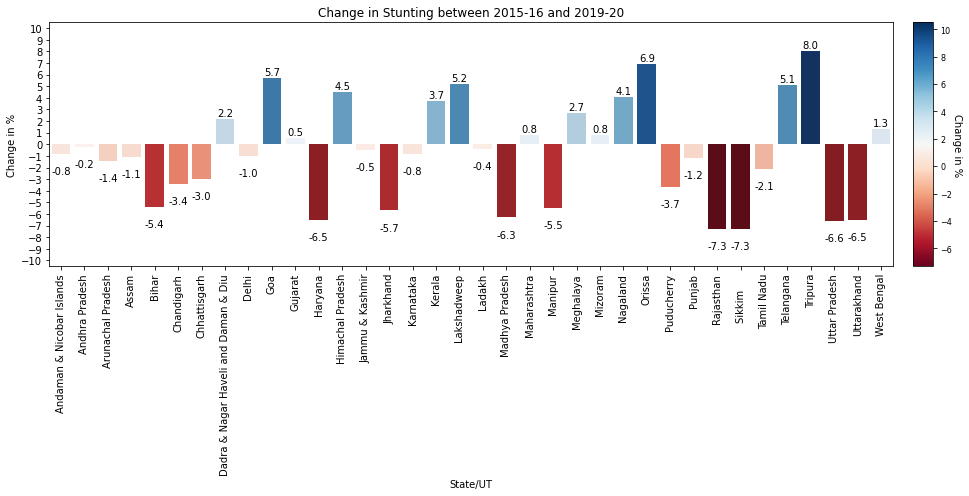
Source: NFHS-5 report
Figure 2: Percentage change in prevalence of wasting in State/UT in India from 2015-16 to 2019-20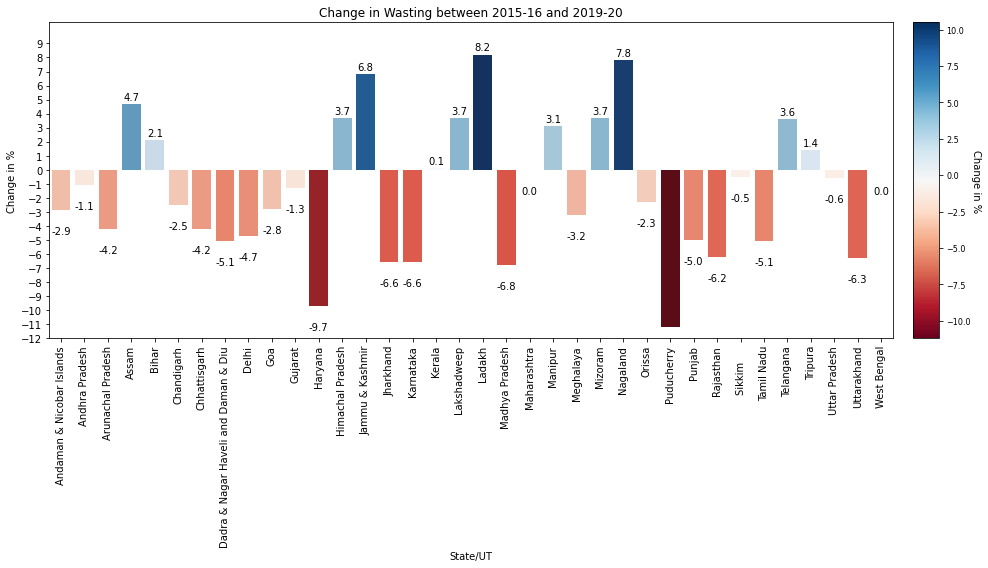
Source: NFHS-5 report
Figure 3: Percentage change in prevalence of underweight in State/UT in India from 2015-16 to 2019-20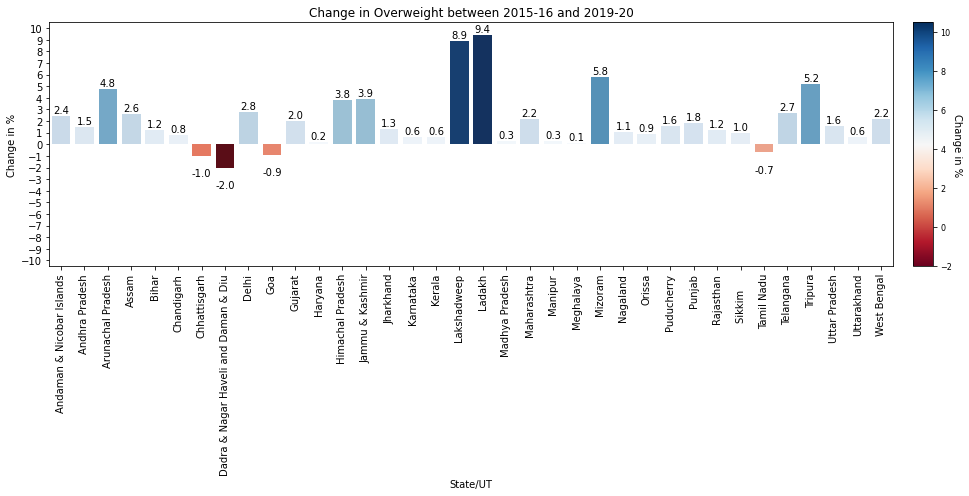
Source: NFHS-5 report
Figure 4: Percentage change in prevalence of overweight in State/UT in India from 2015-16 to 2019-20 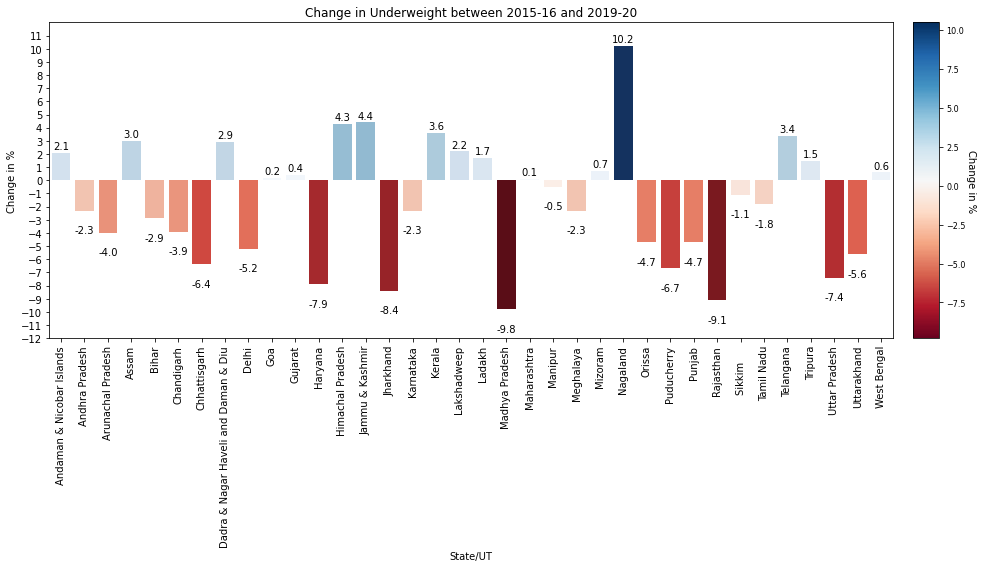
Source: NFHS-5 report
Figure 5: Summary of Stunting, Wasting, Underweight and Overweight in State/UT in India from 2015-16 to 2019-20 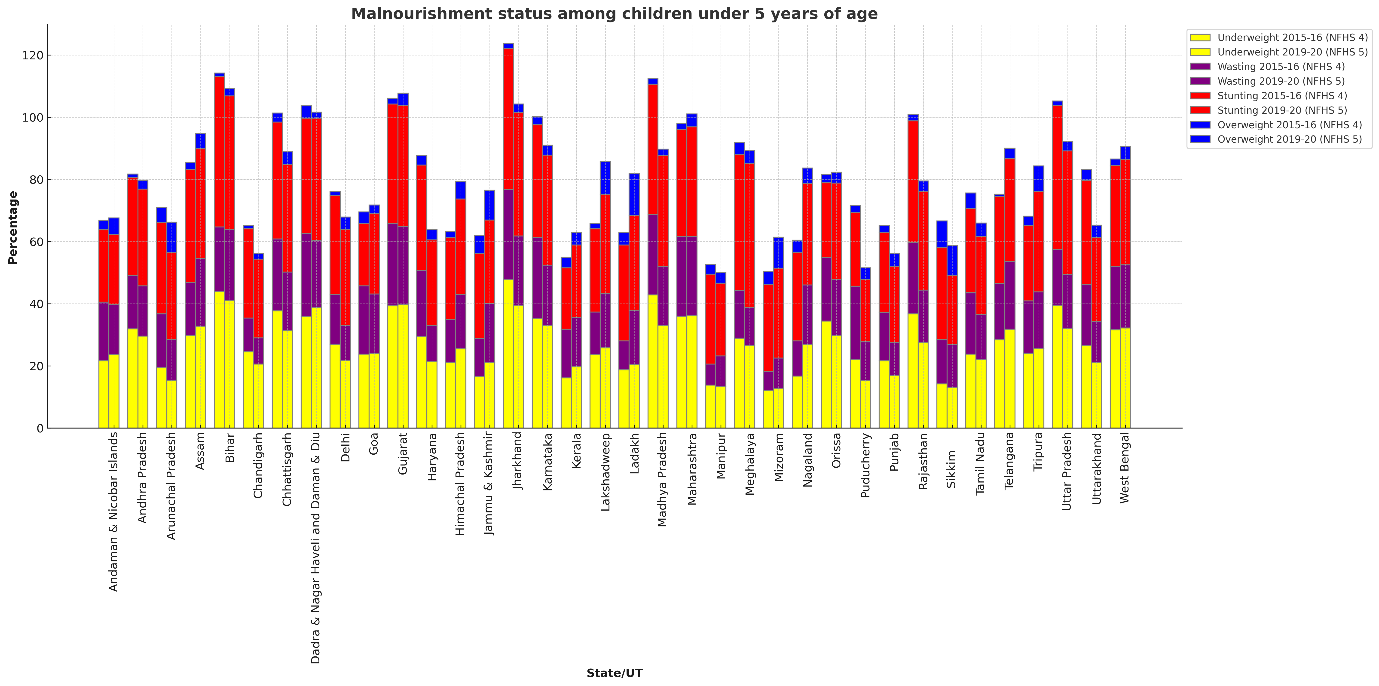
Source: NFHS-5 report
In terms of women's nutrition, Jharkhand faces a severe challenge with the highest percentage of undernourished women at 26.2 percent, while Ladakh shows the best performance for undernourished women at 4.4 percent respectively. In terms of budget allocation, Maharashtra received the most considerable central fund allocation at 60,810 units and also showcased the highest utilisation of these funds, with a total of 43,714 units utilised. Lakshadweep received the lowest central funds at 118 units. Table 1 provides an overview of the total funds assigned and used throughout the states and UTs, while Figure 6 details the allocation and usage of funds for each state.
Table 1: Descriptive analysis of total funds allocated and utilized
| Total Central Funds released (in Lakhs) | Total Central Funds utilised (in Lakhs) | |
| Mean | 14625.345556 | 9922.712667 |
| Standard deviation | 16322.643321 | 11368.748833 |
| Median | 8067.095000 | 5629.215000 |
| Inter quartile range (IQR) | 20687.6 | 14335.2375 |
Source: Study on Impact of Poshan Abhiyan
Figure 6: State-wise funds allocated/ utilised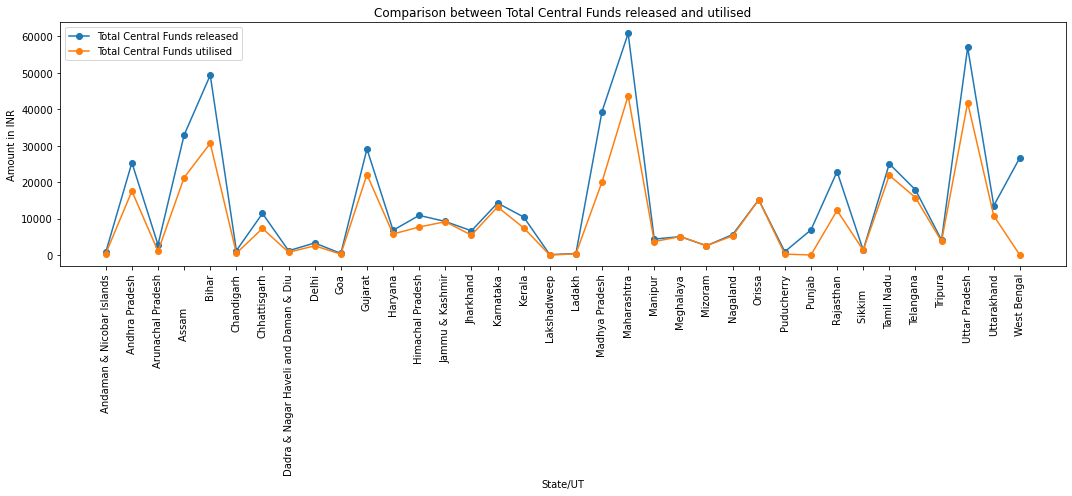
Source: Study on Impact of Poshan Abhiyan
Ensuring better nutrition indicators over time is an important mandate at the policy level. To achieve this, it is imperative to understand the burden of malnourishment at the state level, and the context where the interventions are implemented with the support of diverse actors and sectors. As illustrated in the above figures and table, the social position of the states in the context of nutrition varies in terms of the burden of stunting, wasting, and being underweight and overweight. Noticing this difference in data is important from the policy design and implementation perspective. A robust data infrastructure and real-time monitoring of nutrition indicators will enable the capture of the extent of the burden of the problem. Diving deep into data insights will enable evidence-informed tailored policy interventions, and policy advocacy for the allocation of funds to address specific needs, and promote inter-sectoral collaboration among diverse actors to address multifaceted malnutrition challenges. Data-driven, context-specific, integrated, and holistic policy interventions at the state level are needed to address acute and chronic malnutrition in India.
Sanjay Pattanshetty is Head of the Department of Global Health Governance and Coordinator of Centre for Health Diplomacy, Prasanna School of Public Health, Manipal Academy of Higher Education.
Viola Savy Dsouza is a PhD Scholar at Department of Health Policy, Prasanna School of Public Health.
Shoba Suri is a Senior Fellow at the Observer Research Foundation.
The views expressed above belong to the author(s). ORF research and analyses now available on Telegram! Click here to access our curated content — blogs, longforms and interviews.

Dr. Sanjay M Pattanshetty is Head of theDepartment of Global Health Governance Prasanna School of Public Health Manipal Academy of Higher Education (MAHE) Manipal Karnataka ...
Read More +
Miss. Viola Savy Dsouza is a PhD Scholar at Department of Health Policy Prasanna School of Public Health. She holds a Master of Science degree ...
Read More +
Dr. Shoba Suri is a Senior Fellow with ORFs Health Initiative. Shoba is a nutritionist with experience in community and clinical research. She has worked on nutrition, ...
Read More +